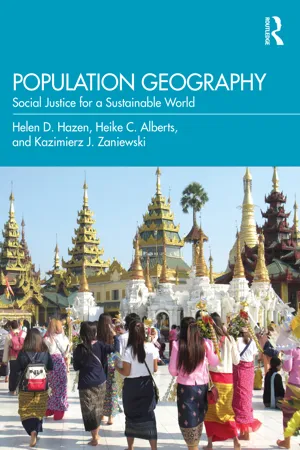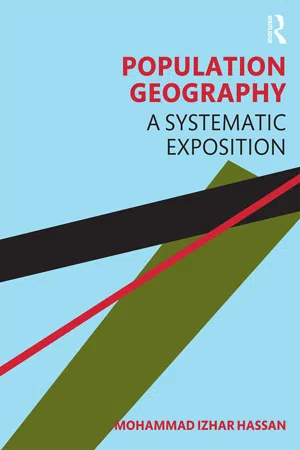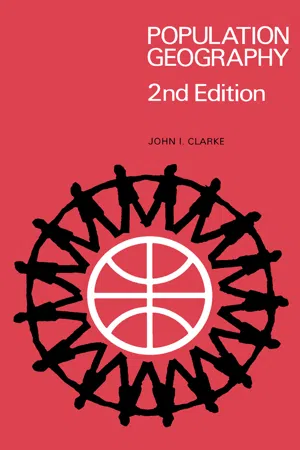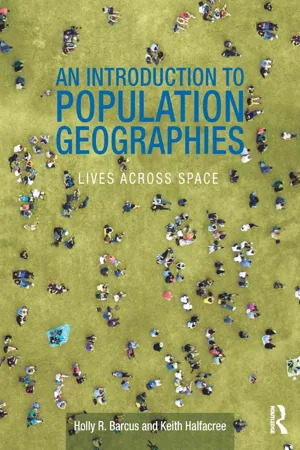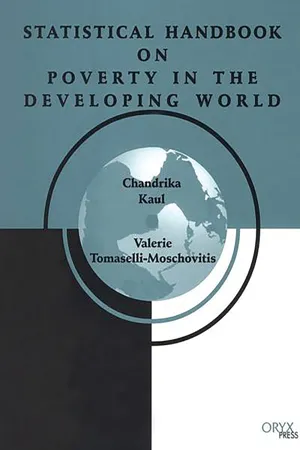Geography
Arithmetic Population Density
Arithmetic population density is a measure of population distribution calculated by dividing the total population of an area by its total land area. It provides a simple way to compare population densities between different regions. This measure is often used in geography to understand the concentration of people in a given area.
Written by Perlego with AI-assistance
Related key terms
1 of 5
8 Key excerpts on "Arithmetic Population Density"
- eBook - PDF
- Julieta Arjona Sumague(Author)
- 2020(Publication Date)
- Society Publishing(Publisher)
Arithmetic Density (1981–2011) Arithmetic density is the most common kind of population density. Arithmetic density is defined as a simple ratio between total population and the total land area. Also, it is the measure of population pressure on land, because it just spells out a simple quantitative relationship that is between man and land. Both man and land may be widely differing quality (Chandna and Sidhu). Rural Population Density (1981–2011) The percentage between a total rural population and total rural area is known as the rural pollution density. Urban Population Density (1981–2011) The percentage between total urban population and total urban area is known as urban population density. Man-land ratio in urban area is a vital element in evaluating the quality and pattern of urban life. Nutritional Density of Population (2001–2011) Nutritional density of population is calculated by total rural population divided by total cropped area. It eliminates the fallow land, but it includes area sown more than once. Population Density 195 Physiological Density of Population (2001–2011) Physiological density is calculated by dividing total population by total cultivated area / Net sown area. The physiological density depicts some of the different trends as compared to arithmetic density for showing the rural economic condition of an area. Progress Check Questions 1 a. What do you understand by population demographics? b. What do you mean by population density? c. What are some physical factors affecting population density? Activity 5.1.3. Post Listening Now that you have listened to the text on population density, write down the various factors that you think can contribute towards the growth of population around the world. Also mention the various measures that must be taken to curtail the population growth. - eBook - PDF
- Rodolfo B. Valdenarro(Author)
- 2019(Publication Date)
- Delve Publishing(Publisher)
Spatial and ancient demography is making more and more use of the sources of data from external Europe. The famous manuals like Population Geography: Problems, Concept and Prospects (Peters and Larkin 2010) educate the new generations the fundamentals of the subject. In the contrary, Adrian Bailey’s (2005) Making Population Geography introduces a wider, more hypothetically informed viewpoint. The current discussions and journal special concerns have paid attention on the variations in the climate change, neo-Malthusianism, kids’ geographies, susceptibility, and alteration, even though migration remains to predominate. 6.4. THE IMPORTANCE OF DENSITY AND COMPOSI-TION The density of the population can be stated as a relation among the number of individuals and a specific unit of measure. The most common of such evaluations is crude or mathematics density. To reach at the crude population density of a place, it is essential to divide the entire number of the individuals who are staying there by the total area of the land. The United States, for instance, has an average density of the population of near about 84 people for each square mile. New York City, though, has a population density of 23,671 On the other hand, some zones of Alaska have Population Geographies 125 population densities of near zero individuals for every square mile. Thus, crude density is considered as a very general evaluation of the distribution of the population. In order to attain a more correct image of the population densities and the importance of variance in demographic features all over the world, one must turn to other forms of measures like the agricultural density, nutritious density, age-sex pyramids, birth rates and death rates. Figure 6.3: Agricultural density is defined as the field of study that explains the ration between, the farmers and the availability of the farmland in that area. - eBook - ePub
Population Geography
Social Justice for a Sustainable World
- Helen D. Hazen, Heike C. Alberts, Kazimierz J. Zaniewski(Authors)
- 2023(Publication Date)
- Routledge(Publisher)
figure 3.4 ).FIGURE 3.4Arithmetic and physiological densities by country, 2018Data sources: FAO (2022) and UNDESA (2019) .Population redistribution
Though the discussion so far has focused on how people have traditionally settled in agriculturally favorable areas, today more than half of the world’s population live in cities. Agricultural productivity has increased significantly in the modern era, freeing large numbers of people from having to perform agricultural labor. At the same time, increasingly integrated trade and transportation networks have allowed people to draw resources from greater distances. Industrial lifestyles have thus reduced people’s dependence on procuring resources from their immediate environment, allowing population to become more concentrated and enabling the growth of cities.As recently as 1800, just 5 percent of the global population lived in cities. Since then, rural-to-urban migration has moved huge numbers of people from the countryside to urban areas as people sought to escape heavy agricultural labor and rural poverty in hopes of better jobs and higher living standards in cities. By 1950 one-third of global population was urban, by 2020 approximately half, and this figure is projected to rise to two-thirds by 2050. Despite the appeal of cities, urban conditions were initially often appalling, as overcrowding fueled disease and wastes built up. This was evident in the cities of Victorian England in the late 1800s and can be seen in the megacities of the Global South today. We expand on the population impacts of urbanization and city living in chapter 12 - eBook - ePub
Population Geography
A Systematic Exposition
- Mohammad Izhar Hassan(Author)
- 2020(Publication Date)
- Routledge India(Publisher)
3 Population distribution The world is the home of over 7.5 billion people distributed over the globe in a very uneven manner. On the one extreme, vast areas including the hot and the cold deserts, the polar areas, the mountain ranges etc. are either uninhabited or very thinly populated. As against this, the fertile plains with favourable climatic conditions are very densely populated. Less than one-fifth of the land surface accommodates nearly nine-tenths of the world population. Population geographers have traditionally been interested in this uneven spatial expression from region to region and from place to place. The present chapter discusses some of the salient features of population distribution in the world, in general, and in India, in particular. Factors affecting population distribution have also been examined. The terms – distribution and density – are frequently used in any discussion on the distribution of human population. It is, therefore, worthwhile to discuss the exact meaning of the terms and their various measures before we embark upon population distribution. Density and distribution Though density and distribution have precise and distinct connotations, they are sometimes used interchangeably. While distribution refers to the actual pattern of spacing of units of individuals over the earth’s surface, density, on the other hand, is an expression of the ratio between number of people and land surface area. Measures of density Crude density, also known as arithmetic density, is the most commonly used measure of population density. It is expressed as the number of people divided by total surface area. India, for example, has an average density of 382 persons per square kilometre, as per the latest census of 2011. Crude or arithmetic density can be worked out separately for rural and urban areas. Being an average figure, crude density suffers from a serious limitation - eBook - PDF
Population Geography
Pergamon Oxford Geographies
- John I. Clarke, W. B. Fisher(Authors)
- 2013(Publication Date)
- Pergamon(Publisher)
C H A P T E R IV MEASURES O F POPULATION DENSITY AND DISTRIBUTION Areal Distributions Many attempts have been made to simplify the complexities of population distributions; to extract the bones by statistical analyses. But as compared with most linear distributions, areal distributions are less easy to analyse because of the irregular size of administrative units, the mobility of population and areal variations in the physical environment. These are also basic problems of population mapping, which attempts a visual presentation of areal data. Subjectivity enters into the preparation of maps through the selection of method (choropleths, isopleths, dots or pro-portional symbols), class intervals (shading categories, isopleth intervals), and the value, size and location of dots and symbols. Moreover, population maps may not be viewed or evaluated in the way intended by the compiler. However, population mapping cannot concern us here, especially as several excellent texts on cartography deal exhaustively with the subject. It is important to emphasize that use of the following methods results in both gain and loss. The gain is a different viewpoint of population distribu-tion; the loss is in the inevitable generalization of data. On balance, it is valuable to consider these methods wherever serious analysis of population distribution is necessary. Population Density The concept of population density, relating numbers of people to the space occupied by them, is one of the most intriguing and most hazardous correlations employed by geographers. First used in 1837 by Henry Drury Harness in a series of maps for the commission considering the railways of Ireland, it has since developed as a means partly of assessing overpopulation and underpopulation — by comparing existing and potential densities — but mainly of obtaining an index for purposes of areal comparison. - eBook - ePub
An Introduction to Population Geographies
Lives Across Space
- Holly R. Barcus, Keith Halfacree(Authors)
- 2017(Publication Date)
- Routledge(Publisher)
There is a clear prima facie case for the discipline of Demography : “the scientific study of the size, composition, and distribution of human populations and their changes resulting from fertility, mortality, and migration” (Poston and Bouvier 2010: 3). Births, deaths and human migrations between locations across the globe certainly require measurement, presentation and discussion, and future trends predicted. But whilst Demography also involves itself with the causes of the patterns, trends and magnitudes it identifies—“the factors that affect these components” (Poston and Bouvier 2010: 3)—a more dedicated emphasis on their contextualized spatial expression has become the focus of Population Geography. 1.2.2 … across real places Population Geography can be defined initially as the study of “the geographical organization of population and how and why this matters to society” (Bailey 2005: 1). An immediate illustration of how such a spatial lens is both significant and important comes, once again, via some simple demographic facts about the state of the world today (developed more fully in Chapter 3). Consider infant mortality rates (10.3.1) in a small selection of countries in Asia and Europe, shown in Table 1.1. First, even across these ten countries there is a considerable range of values. This is true even within the same continent, such as the contrast between Romania and Norway in Europe. Second, although there is a general trend towards declining infant mortality, countries such as Mongolia and India retain extremely high rates. Furthermore, many countries affected by civil strife, such as Afghanistan, Congo or Iraq, are understandably unable to provide data. Thus, Table 1.1 is biased in favor of countries experiencing relative political stability - eBook - PDF
Global Mapping of Infectious Diseases
Methods, Examples and Emerging Applications
- (Author)
- 2007(Publication Date)
- Academic Press(Publisher)
Measures of population counts and density distributions have broad-scale health applications. Although the bulk of this section addresses the latter, a brief review of the former is also included, in part, because gridded population data act as a proxy for a host of other health-related data. 4.1. General Health Studies Regional studies of mortality and malnutrition have focused largely on understanding biological and socioeconomic factors associated with those outcomes. Spatially explicit data on those outcomes is typically not available. When survey or clinic data are georeferenced, as is increasingly the case, it becomes possible to consider a range of spatially explicit factors, including population density. Density relates to disease transmission—and ultimately health status—in a variety of ways. For example, person-to-person transmission is likely to be high in densely populated urban areas, though such areas may reduce the potential for particular vector habitats. Population density estimates also provide continuous measures of the degree of urbanness (such as high-density core urban areas or less dense semi-urban areas). In the absence of explicit data on the mode of disease transmission, or the vector habitat, and with careful use, population density may be a useful proxy for an urban continuum. In a study of West African mortality, Balk and colleagues (2004) confirm the complexities associated with measuring and interpreting population density: in urban areas, increases in population density reduced the risk of infant deaths, and the further away from an urban DETERMINING GLOBAL POPULATION DISTRIBUTION 139 area, the greater the likelihood of infant death. In this study, density (GPW v3) and the GRUMP urban extent mask (alpha version) are used as proxy variables for clinic or health services density (which were not directly measured). - Chandrika Kaul, Valerie Tomaselli-Moschovitis, Chandrika Kaul, Valerie Tomaselli-Moschovitis(Authors)
- 1999(Publication Date)
- Greenwood(Publisher)
Population Growth Rates: Growth rates in popu- lation show the change over a designated period of time in the size of a country's population. For the students and policymakers concerned with poverty, they are a cru- cial indicator of the pressure exerted on a country's natu- ral, economic, and social resources (health care and education, for instance). Controlling rapidly accelerat- ing growth rates is one of the primary concerns of policymakers in developing countries (D2.1-D2.3). Population Density: As a measure of the number of people per unit of land area, population density is one of the most basic indicators of the human pressure on natural resources. As population growth rates (see above) accelerate—and the land area of a country remains the same—population density increases. Increasing pressure on existing land resources may engender health and en- vironmental concerns, such as inadequate food supply and unhealthy sanitation, if the growth of appropriate infrastructure lags behind (D3.1-D3.3). Rural Population Density: The rural component of population density helps analysts and students moni- tor the potential population pressure on rural communi- ties. This demographic pressure is important, as some rural environments are already strained to accommodate existing populations, and accelerating rural population density trends indicate potential increased threats to the survival (outstripping of food supply, for instance), health concerns, and infrastructure in these communities (D4.1- D4.4). Urban Population and Growth Rates: Often in de- veloping countries, urban population growth rates are higher than those in rural areas and continue to acceler- ate at an astronomical rate, as economic needs push people towards centers of population where economic opportunity is most often the highest.
Index pages curate the most relevant extracts from our library of academic textbooks. They’ve been created using an in-house natural language model (NLM), each adding context and meaning to key research topics.


